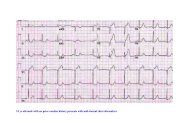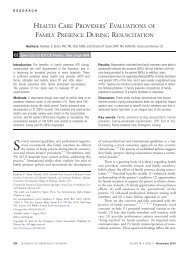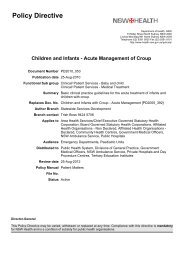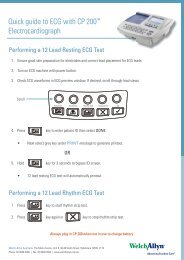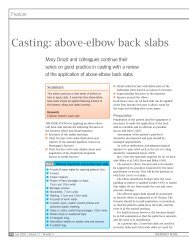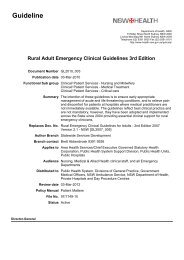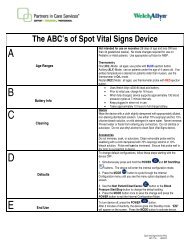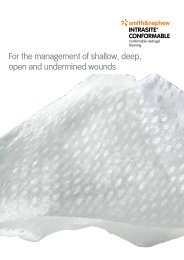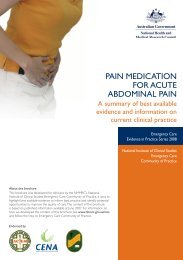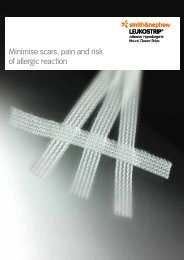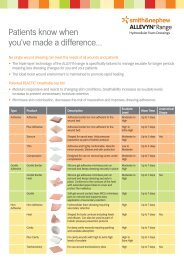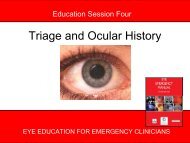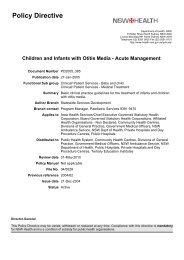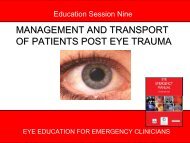Clinical Guidelines for Acute Stroke Management - Living on the EDge
Clinical Guidelines for Acute Stroke Management - Living on the EDge
Clinical Guidelines for Acute Stroke Management - Living on the EDge
Create successful ePaper yourself
Turn your PDF publications into a flip-book with our unique Google optimized e-Paper software.
GLOSSARY AND ABBREVIATIONS<br />
Activities of daily living: The basic elements of<br />
pers<strong>on</strong>al care such as eating, washing and showering,<br />
grooming, walking, standing up from a chair and using<br />
<strong>the</strong> toilet.<br />
Activity: The executi<strong>on</strong> of a task or acti<strong>on</strong> by an<br />
individual. Activity limitati<strong>on</strong>s are difficulties an<br />
individual may have in executing activities.<br />
Agnosia: The inability to recognise sounds, smells,<br />
objects or body parts (o<strong>the</strong>r people’s or <strong>on</strong>e’s own)<br />
despite having no primary sensory deficits.<br />
Aphasia: Impairment of language, affecting <strong>the</strong><br />
producti<strong>on</strong> or comprehensi<strong>on</strong> of speech and <strong>the</strong> ability<br />
to read and write.<br />
Apraxia: Impaired planning and sequencing of<br />
movement that is not due to weakness,<br />
incoordinati<strong>on</strong>, or sensory loss.<br />
Atrial fibrillati<strong>on</strong>: Rapid, irregular beating of <strong>the</strong> heart.<br />
Augmentative and alternative communicati<strong>on</strong>:<br />
N<strong>on</strong>-verbal communicati<strong>on</strong>, e.g. through gestures or<br />
by using computerised devices.<br />
Deep vein thrombosis: Thrombosis (a clot of blood)<br />
in <strong>the</strong> deep veins of <strong>the</strong> leg, arm, or abdomen.<br />
Disability: A defect in per<str<strong>on</strong>g>for</str<strong>on</strong>g>ming a normal activity or<br />
acti<strong>on</strong> (e.g. inability to dress or walk).<br />
Dysarthria: Impaired ability to produce clear speech<br />
due to <strong>the</strong> impaired functi<strong>on</strong> of <strong>the</strong> speech muscles.<br />
Dysphagia: Difficulty swallowing.<br />
Dysphasia: Reduced ability to communicate using<br />
language (spoken, written or gesture).<br />
Dyspraxia of speech: Inability to produce clear<br />
speech due to impaired planning and sequencing of<br />
movement in <strong>the</strong> muscles used <str<strong>on</strong>g>for</str<strong>on</strong>g> speech.<br />
Emoti<strong>on</strong>alism: An increase in emoti<strong>on</strong>al behaviour -<br />
usually crying, but sometimes laughing that is outside<br />
normal c<strong>on</strong>trol and may be unpredictable as a result of<br />
<strong>the</strong> stroke.<br />
Enteral tube feeding: Delivery of nutrients directly into<br />
<strong>the</strong> intestine via a tube.<br />
Executive functi<strong>on</strong>: Cognitive functi<strong>on</strong>s usually<br />
associated with <strong>the</strong> fr<strong>on</strong>tal lobes including planning,<br />
reas<strong>on</strong>ing, time percepti<strong>on</strong>, complex goal-directed<br />
behaviour, decisi<strong>on</strong> making and working memory.<br />
Family support / liais<strong>on</strong> worker: Apers<strong>on</strong>who<br />
assists stroke survivors and <strong>the</strong>ir families to achieve<br />
improved quality of life by providing psychosocial<br />
support and in<str<strong>on</strong>g>for</str<strong>on</strong>g>mati<strong>on</strong>, referrals to o<strong>the</strong>r stroke<br />
service providers.<br />
Impairment: A problem in <strong>the</strong> structure of <strong>the</strong> body<br />
(e.g. loss of a limb) or <strong>the</strong> way <strong>the</strong> body or a body part<br />
functi<strong>on</strong>s (e.g. hemiplegia).<br />
Infarcti<strong>on</strong>: Death of cells in an organ (e.g. <strong>the</strong> brain or<br />
heart) due to lack of blood supply.<br />
Inpatient stroke care coordinator: A pers<strong>on</strong> who<br />
works with people with stroke and with <strong>the</strong>ir carers to<br />
c<strong>on</strong>struct care plans and discharge plans and to help<br />
coordinate <strong>the</strong> use of health care services during<br />
recovery in hospital.<br />
Interdisciplinary team: The entire rehabilitati<strong>on</strong> team,<br />
made up of doctors, nurses, <strong>the</strong>rapists, social<br />
workers, psychologists etc.<br />
Ischaemia: An inadequate flow of blood to part of <strong>the</strong><br />
body due to blockage or c<strong>on</strong>stricti<strong>on</strong> of <strong>the</strong> arteries<br />
that supply it.<br />
Neglect: The failure to attend or resp<strong>on</strong>d to, or make<br />
movements towards <strong>on</strong>e side of <strong>the</strong> envir<strong>on</strong>ment.<br />
Participati<strong>on</strong>: Involvement in a life situati<strong>on</strong>.<br />
Participati<strong>on</strong> restricti<strong>on</strong>s: are problems an individual<br />
may experience in involvement in life situati<strong>on</strong>s.<br />
Percutaneous endoscopic gastrostomy (PEG): A<br />
<str<strong>on</strong>g>for</str<strong>on</strong>g>m of enteral feeding in which nutriti<strong>on</strong> is delivered<br />
via a tube that is surgically inserted into <strong>the</strong> stomach<br />
through <strong>the</strong> skin.<br />
Ph<strong>on</strong>ological deficits: Language deficits<br />
characterised by impaired recogniti<strong>on</strong> and/or selecti<strong>on</strong><br />
of speech sounds.<br />
Pulm<strong>on</strong>ary embolism: Blockage of <strong>the</strong> pulm<strong>on</strong>ary<br />
artery (which carries blood from <strong>the</strong> heart to <strong>the</strong> lungs)<br />
with a solid material, usually a blood clot or fat, that<br />
has travelled <strong>the</strong>re via <strong>the</strong> circulatory system.<br />
Rehabilitati<strong>on</strong>: Restorati<strong>on</strong> of <strong>the</strong> disabled pers<strong>on</strong> to<br />
optimal physical and psychological functi<strong>on</strong>al<br />
independence.<br />
Risk factor: A characteristic of a pers<strong>on</strong> (or people)<br />
that is positively associated with a particular disease or<br />
c<strong>on</strong>diti<strong>on</strong>.<br />
Glossary and Abbreviati<strong>on</strong>s<br />
73



